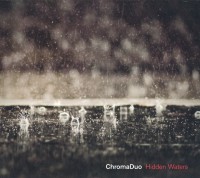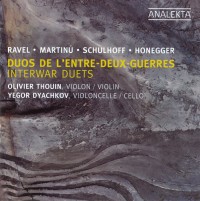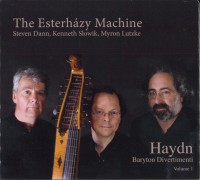 Musica Intima could well be the title of my column this month as I find myself immersed in new recordings by two duets and a trio. The ChromaDuo is comprised of Canadian guitar virtuosos Tracy Anne Smith and Rob MacDonald. Founded in 2009, the duo is active across the continent and internationally. They specialize in music of the 21st century and have a body of commissioned work, some of which is showcased on their debut recording Hidden Waters where four of six tracks were written especially for them. The disc opens with one of the two exceptions, The Raw and the Cooked by British composer Stephen Goss, a set of miniatures drawing on a number of musical influences from Django Reinhardt to David Byrne to the Mahavishnu Orchestra. While the composer’s program note does not convey any direct link to the book of the same name by anthropologist Claude Lévi-Strauss, it does explain that the influences are in some cases near the surface (the Raw) and in others buried deeply within the texture (the Cooked). Even when the inspiration is as distinctive as Astor Piazzolla the music is not obviously derivative or clichéd, and although many of them originate in popular forms these compositions are firmly rooted in world of art music. The nine selected movements from Goss’ suite are followed by Still the Sea, which Goss composed for ChromaDuo in 2009. This primarily gentle set of pieces pays tribute to the music and on-going influence of the late, great Japanese composer Toru Takemitsu, himself no stranger to writing for the guitar, and Takemitsu’s own self-stated influences Debussy, Nature and Duke Ellington. The music of Goss gives way to two pieces composed for Chroma by American Christopher William Pierce in the form of an Adagio and Fugue, inspired by Bach and Debussy, and Three Pieces for Two Guitars which adds influences of Ligeti to the mix. Here introspective pieces are contrasted with a central Allegro Ritmico which while reminiscent of a gentle spring rain gives way to momentary tempestuous outbursts. The title of the disc in derived from another piece composed for the duo, Niterói, which means “hidden waters” in Tupi, a native language of Brazil, and is the name of the Brazilian city which provided the inspiration. This multi-layered work has dense textures, complex rhythms and employs a number of extended techniques providing the duo with an opportunity to really show their chops. I am very impressed with their consummate ensemble work and the cleanness of their sound – no extraneous finger noise audible here, perhaps in part due to the impeccable recording skills of engineer Norbert Kraft who seems also to be a mentor for the group. If you missed the CD launch at Gallery 345 on April 22 you can find the disc on Tracy Anne Smith’s website: http://tracyannesmith.com/discography.
Musica Intima could well be the title of my column this month as I find myself immersed in new recordings by two duets and a trio. The ChromaDuo is comprised of Canadian guitar virtuosos Tracy Anne Smith and Rob MacDonald. Founded in 2009, the duo is active across the continent and internationally. They specialize in music of the 21st century and have a body of commissioned work, some of which is showcased on their debut recording Hidden Waters where four of six tracks were written especially for them. The disc opens with one of the two exceptions, The Raw and the Cooked by British composer Stephen Goss, a set of miniatures drawing on a number of musical influences from Django Reinhardt to David Byrne to the Mahavishnu Orchestra. While the composer’s program note does not convey any direct link to the book of the same name by anthropologist Claude Lévi-Strauss, it does explain that the influences are in some cases near the surface (the Raw) and in others buried deeply within the texture (the Cooked). Even when the inspiration is as distinctive as Astor Piazzolla the music is not obviously derivative or clichéd, and although many of them originate in popular forms these compositions are firmly rooted in world of art music. The nine selected movements from Goss’ suite are followed by Still the Sea, which Goss composed for ChromaDuo in 2009. This primarily gentle set of pieces pays tribute to the music and on-going influence of the late, great Japanese composer Toru Takemitsu, himself no stranger to writing for the guitar, and Takemitsu’s own self-stated influences Debussy, Nature and Duke Ellington. The music of Goss gives way to two pieces composed for Chroma by American Christopher William Pierce in the form of an Adagio and Fugue, inspired by Bach and Debussy, and Three Pieces for Two Guitars which adds influences of Ligeti to the mix. Here introspective pieces are contrasted with a central Allegro Ritmico which while reminiscent of a gentle spring rain gives way to momentary tempestuous outbursts. The title of the disc in derived from another piece composed for the duo, Niterói, which means “hidden waters” in Tupi, a native language of Brazil, and is the name of the Brazilian city which provided the inspiration. This multi-layered work has dense textures, complex rhythms and employs a number of extended techniques providing the duo with an opportunity to really show their chops. I am very impressed with their consummate ensemble work and the cleanness of their sound – no extraneous finger noise audible here, perhaps in part due to the impeccable recording skills of engineer Norbert Kraft who seems also to be a mentor for the group. If you missed the CD launch at Gallery 345 on April 22 you can find the disc on Tracy Anne Smith’s website: http://tracyannesmith.com/discography.
 The next disc is one that I should probably have turned over to Terry Robbins for his “Strings Attached” column, but citing “Editor’s prerogative” I have chosen to keep it for myself. Interwar Duets (Analekta AN 2 9971) features familiar and unfamiliar works for violin and cello performed with aplomb and vigour by Olivier Thouin and Yegor Dyachkov. Most familiar is the Sonata for Violin and Cello completed in 1922 by Maurice Ravel. I remember once, after not hearing this extremely virtuosic work in a decade or so, tuning in to a radio broadcast during the Vif, avec entrain final movement and wondering “Oh that’s so familiar, which quartet is that?” – such is the dexterity required of the two musicians. Thouin, currently associate concertmaster of the Orchestre symphonique de Montréal, and well known soloist Dyachkov take it all in stride. They make it sound easy, even effortless, while capturing all the excitement and nuance of the moment. This consummate musicianship is on show throughout the disc, which includes lesser known but delightful duets by Martinu and Honegger. But the real gem for me is the offering by Erwin Schulhoff, composed in 1925. More and more music of this Nazi-designated “Degenerate” composer is gaining attention in recent years and with each new discovery our awareness of the tragedy of the composer’s death in a concentration camp becomes more acute. Schulhoff’s Duet is in the classical four movement form of the sonata. Framed by dramatic rondos utilizing “modal language pushed to the edge of atonality,” the central movements include Zingaresca - a rollicking Gypsy dance - and a sombre Andantino. Although one might wonder whether the stark combination of violin and cello could sustain the listener’s interest for the duration of the disc, I had no problem with attention deficit during these marvellous performances.
The next disc is one that I should probably have turned over to Terry Robbins for his “Strings Attached” column, but citing “Editor’s prerogative” I have chosen to keep it for myself. Interwar Duets (Analekta AN 2 9971) features familiar and unfamiliar works for violin and cello performed with aplomb and vigour by Olivier Thouin and Yegor Dyachkov. Most familiar is the Sonata for Violin and Cello completed in 1922 by Maurice Ravel. I remember once, after not hearing this extremely virtuosic work in a decade or so, tuning in to a radio broadcast during the Vif, avec entrain final movement and wondering “Oh that’s so familiar, which quartet is that?” – such is the dexterity required of the two musicians. Thouin, currently associate concertmaster of the Orchestre symphonique de Montréal, and well known soloist Dyachkov take it all in stride. They make it sound easy, even effortless, while capturing all the excitement and nuance of the moment. This consummate musicianship is on show throughout the disc, which includes lesser known but delightful duets by Martinu and Honegger. But the real gem for me is the offering by Erwin Schulhoff, composed in 1925. More and more music of this Nazi-designated “Degenerate” composer is gaining attention in recent years and with each new discovery our awareness of the tragedy of the composer’s death in a concentration camp becomes more acute. Schulhoff’s Duet is in the classical four movement form of the sonata. Framed by dramatic rondos utilizing “modal language pushed to the edge of atonality,” the central movements include Zingaresca - a rollicking Gypsy dance - and a sombre Andantino. Although one might wonder whether the stark combination of violin and cello could sustain the listener’s interest for the duration of the disc, I had no problem with attention deficit during these marvellous performances.
 I cannot say the same for the final disc Haydn Baryton Divertimenti Volume One (FofM 36-811 www.smithsonian.org) which features five trios for baryton, viola and cello performed by the Smithsonian Institute’s resident Esterházy Machine (Kenneth Slowik, Steven Dann and Myron Lutzke). This is not to say that I did not find the music and performances of interest, simply that taken as a whole I found the 66 minute experience a bit “much of a muchness.” I think I would likely feel the same if offered a steady diet of Haydn piano trios or string quartets however, so that being said I find this recording has a lot to offer if taken in moderation. The baryton, a favourite instrument of Haydn’s Esterházy patron Prince Nicholas the Magnificent, is an unusual instrument, kind of a hybrid viol and lute, which is pretty much extinct today. The instrument played here by Kenneth Slowik, presumably from the Smithsonian Collection, was built in 1986 by George Cassis of Baltimore, Maryland after 18th century Viennese models. With six (or seven) gut strings and a fretted neck, the baryton resembles a viol da gamba and is similarly held between the knees and played with a bow. The difference is a rank of brass and steel strings which run under and through the hollow fingerboard in such a way that they can vibrate sympathetically or be plucked individually by the thumb of the left hand through the open back of the neck to create counterpoint with the melody strings. The effect is more subtle than a written description may suggest. There is nothing resembling the resonance of the sympathetic strings of the sitar here for instance, but rather a delicate extension to the overall ambience of the melodic playing and added colour from the plucked steel strings producing a harp-like texture. The range of the baryton overlaps with the viola and cello so that there is a lush blending of the instruments and we are not always sure from which the melody is originating, which can make for some intriguing listening. We are often amazed at Haydn’s prolific output – 68 string quartets, 104 symphonies – but these numbers pale in comparison to the more than 170 works which incorporate the baryton, including 123 trios for the forces here. Taken two or three at a time they make for pleasant, entertaining listening, but I must confess I hope that “Volume One” does not imply that we can look forward to another 23 volumes to complete the set!
I cannot say the same for the final disc Haydn Baryton Divertimenti Volume One (FofM 36-811 www.smithsonian.org) which features five trios for baryton, viola and cello performed by the Smithsonian Institute’s resident Esterházy Machine (Kenneth Slowik, Steven Dann and Myron Lutzke). This is not to say that I did not find the music and performances of interest, simply that taken as a whole I found the 66 minute experience a bit “much of a muchness.” I think I would likely feel the same if offered a steady diet of Haydn piano trios or string quartets however, so that being said I find this recording has a lot to offer if taken in moderation. The baryton, a favourite instrument of Haydn’s Esterházy patron Prince Nicholas the Magnificent, is an unusual instrument, kind of a hybrid viol and lute, which is pretty much extinct today. The instrument played here by Kenneth Slowik, presumably from the Smithsonian Collection, was built in 1986 by George Cassis of Baltimore, Maryland after 18th century Viennese models. With six (or seven) gut strings and a fretted neck, the baryton resembles a viol da gamba and is similarly held between the knees and played with a bow. The difference is a rank of brass and steel strings which run under and through the hollow fingerboard in such a way that they can vibrate sympathetically or be plucked individually by the thumb of the left hand through the open back of the neck to create counterpoint with the melody strings. The effect is more subtle than a written description may suggest. There is nothing resembling the resonance of the sympathetic strings of the sitar here for instance, but rather a delicate extension to the overall ambience of the melodic playing and added colour from the plucked steel strings producing a harp-like texture. The range of the baryton overlaps with the viola and cello so that there is a lush blending of the instruments and we are not always sure from which the melody is originating, which can make for some intriguing listening. We are often amazed at Haydn’s prolific output – 68 string quartets, 104 symphonies – but these numbers pale in comparison to the more than 170 works which incorporate the baryton, including 123 trios for the forces here. Taken two or three at a time they make for pleasant, entertaining listening, but I must confess I hope that “Volume One” does not imply that we can look forward to another 23 volumes to complete the set!
We welcome your feedback and invite submissions. CDs and comments should be sent to: The WholeNote, 503 – 720 Bathurst St. Toronto ON M5S 2R4.
David Olds
DISCoveries Editor
discoveries@thewholenote.com



